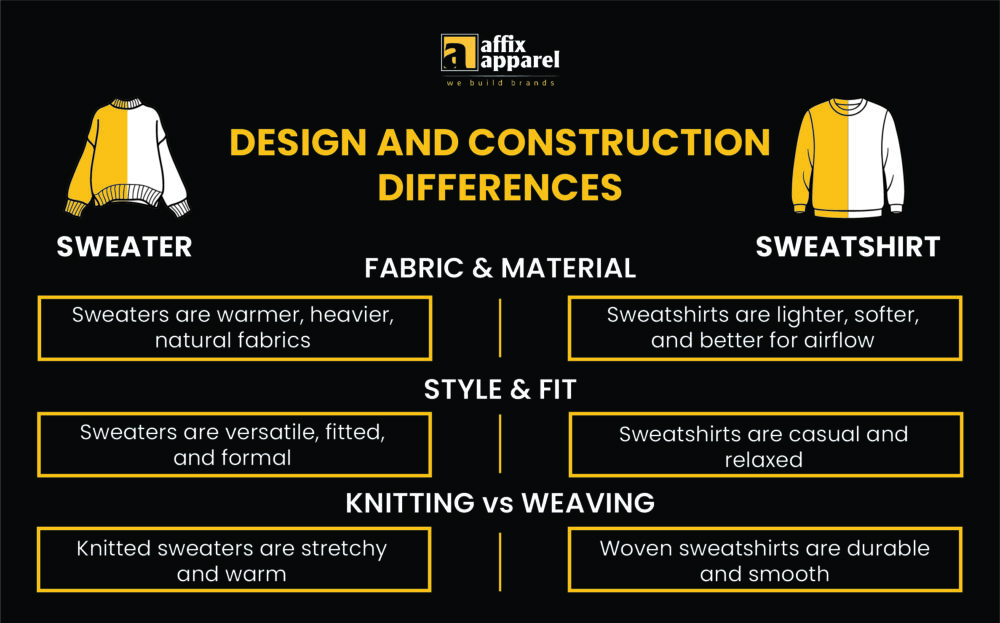Have you ever considered what truly separates a sweater from a sweatshirt? This question is frequently asked in the fashion industry and understanding its importance could significantly impact your clothing brand. Both are comfortable and ideal for colder temperatures, however, they each have their distinctive design and purpose. In this blog post, we’ll break down the key features of sweaters vs sweatshirts to help you decide which option is best for your next design!
Sweatshirt vs Sweater: The Basic Difference
Sweatshirts and sweaters are effective in maintaining warmth, but their origins as cotton practice jerseys on the field are where the ‘sweat’ in their name comes from. Because they come from the same root word, they are frequently interchanged. Understanding the basic difference between sweater vs sweatshirt is important for clothing brands.Â
Sweatshirt Definition
You must be thinking what’s a sweatshirt? A sweatshirt is a cozy, informal clothing item commonly linked with sports attire. Sweatshirts are usually created from fleece or cotton mixes and are crafted to be comfortable and convenient to put on. Fleece is great for cold weather due to its soft insulating layer, whereas cotton blends provide comfort and breathability.

For people who question, “Is hoodie a type of sweatshirtâ€, sweatshirts are available in designs like hoodies with a hood and a front pocket, and crewnecks with a round neckline and no collar. These clothes are famous for their loose fit and are ideal for relaxing, working out, or achieving a casual, laid-back style.
Learn more about: Types Of Material For A Hoodie- Choose The Right Material
Sweater DefinitionÂ
Now here’s a difference. A sweater is a knitted fabric piece of clothing mainly made to keep you warm. Crafted from wool, cotton, or synthetic materials, sweaters are adaptable and available in a range of designs. Wool is the classic option known for its great insulation, whereas cotton offers a lighter and more breathable alternative. Synthetic fibers can improve the strength and flexibility.Â

Is pullover and sweater the same thing? This is the frequently asked question by many. Regular designs of sweaters consist of cardigans, which have an opening at the front and are typically secured with buttons, and pullovers, which are put on by pulling over the head. Sweaters come in various weights, spanning from light to chunky, which allows for layering in casual and formal environments.
Learn more about: Explore The Cardigan – 12 Different Types of Cardigans
Design & Construction Differences
Having a clear understanding of the difference between sweater and sweatshirt design and construction is essential for any clothing brand. These sweater sweatshirt difference impact both the appearance and functionality of the clothing, as well as their appeal to customers. Every part – from the materials to the construction methods to the style and fit that result – is crucial in defining these well-liked clothing items.
Fabric and Material Differences
One of the most noticeable sweatshirt and sweater difference is the materials utilized. Sweaters are commonly crafted from natural materials such as wool and cotton, or artificial materials like acrylic. These fabrics provide sweaters with a comforting, snug sensation, ideal for chilly temperatures. These sweater materials are usually bulkier and sturdier, offering great insulation.
Alternatively, sweatshirts are typically crafted from a mixture of cotton or fleece fabric. These items are more gentle and less heavy, providing a cozy and laid-back feel making them the most liked sweatshirt materials. Sweatshirts are crafted to allow airflow and draw moisture away, suitable for both leisure and sports.
Style and Fit
Sweaters or sweatshirts vary in their style, fit, and common purposes. Sweaters often come in a more custom fit, offered in designs such as cardigans, pullovers, and turtlenecks, allowing them to be worn in both casual and formal situations. They can be worn over shirts for a more put-together appearance or on their own for a comfortable and snug feel.
Alternatively, sweatshirts typically feature a more relaxed, loose fit, often found in designs like hoodies and crewnecks. These are ideal for relaxed activities like going out, playing sports, or relaxing at home. It is essential to keep in mind the specific fashion requirements and events when choosing which garment types to include in your clothing collection, as each style and fit serves a different purpose.
Knitting vs Weaving
The methods utilized in making sweaters and sweatshirts, such as knitting and weaving, greatly influence how they feel and look. Most sweaters are made by knitting, which includes connecting loops of yarn to form a flexible, stretchy material. This method of knitting creates different textures and patterns, making sweaters warm, stylish, and versatile for various occasions.Â
On the other hand, sweatshirts are crafted through weaving, where threads are crossed at 90-degree angles to produce a fabric that is stronger and more organized. This method of weaving creates a smoother and denser texture, perfect for clothing made for comfort and longevity. Deciding whether to knit or weave a garment will impact its flexibility, warmth, and style.
Functional Differences

Every piece of clothing provides distinct advantages and fulfills various needs, ranging from seasonal clothing to adaptability and specific usage situations. This part will examine the sweatshirt versus sweater functional differences, offering insights into their optimal uses in different situations.
Layering and Versatility
A major benefit of sweaters and sweatshirts is their versatility for layering and styling with other clothes. Sweaters can be worn under jackets or over shirts to create a stylish and cohesive appearance suitable for both casual and semi-formal occasions. They are available in different designs like cardigans and pullovers, that can be effortlessly paired with other clothing items.
Sweatshirts, appreciated for being relaxed and cozy, are ideal for wearing over t-shirts or under jackets. They are perfect for a relaxed, informal look and can also make a big impact when showcasing bold designs or logos.
Learn more about: Coat vs Jacket: How To Know The Difference
Seasonal Wear
When considering seasonal clothing, sweaters and sweatshirts have their best seasons. Sweaters in comparison to sweatshirts are usually recommended for colder seasons because they are commonly crafted from materials such as wool or thick knits, which offer great insulation. They are ideal for staying cozy in the autumn and winter seasons.
Conversely, sweatshirts compared to sweaters, typically crafted from fleece or cotton blends, are adaptable and suitable for wearing in different seasons. Although they provide warmth, they are usually lighter and more breathable, making them appropriate for cooler spring and autumn days, and even cold summer nights.
Purpose and Usage
People ask, “is sweater and sweatshirt the same?†Sweaters and sweatshirts have different functions and are appropriate for different situations. Sweaters are extremely flexible, easily transitioning between casual and formal events. They are versatile and can be worn for work, dinner gatherings, or casual events, becoming a wardrobe essential for many people. Their complexity in knitting makes them look more elegant and appropriate for both daily use and formal occasions.
On the other hand, sweatshirts are mainly linked with informal and sporty clothing. They are ideal for relaxing, running errands, or participating in sports. Sweatshirts are created with a loose fit and prioritizing comfort, making them perfect for casual wear and athleisure.
Cost Differences

Multiple factors, such as materials, brand positioning, and clothing manufacturing cost estimation, play a role in determining the price differences in comparison of sweaters against sweatshirts.
Price of Sweaters
Sweaters are usually pricier in sweater and sweatshirt comparison because of the materials and construction methods employed. Most high-end sweaters are crafted from the best fabrics for sweaters like wool, cashmere, or merino, which are pricier than the common cotton or polyester blends found in sweatshirts. The making of sweaters involves more manual work and time, which leads to increased manufacturing expenses.Â
Moreover, sweaters frequently include elaborate designs, patterns, and decorations, leading to a potential rise in their cost. Consequently, there is a wide range of retail prices for sweaters, with options ranging from $10-$50 to designer pieces that cost several hundred dollars or more.
Price of Sweatshirts
Sweatshirts typically cost less than sweaters due to their simpler materials and construction. The majority of sweatshirts are constructed from cotton, fleece, or synthetic blends, which are more economical compared to the wool or cashmere found in numerous sweaters. The production of sweatshirts usually requires simpler and cheaper weaving and assembly processes.
Also, sweatshirts frequently feature a more relaxed and functional style, reducing production expenses. Although designer or branded sweatshirts may come with a higher price tag, most sweatshirts are generally priced between $15 and $60, making them more affordable for the average consumer. Nonetheless, exclusive or premium sweatshirts from renowned labels may also exceed $100 in price.
The Care Instructions
Understanding the correct way to maintain your sweatshirts and sweaters is essential to preserving their appearance and comfort over time. Read on to learn more about the care instructions for both.Â
Care Instructions for Sweaters
Properly caring for sweaters is crucial to preserve their look and durability. Sweaters crafted from fragile fabrics such as wool or cashmere need to be handled with care. It is advisable to wash by hand in cold water with a gentle detergent to avoid shrinking and keep the fabric soft.
Refrain from twisting water out; instead, softly squeeze out moisture with a towel and lie flat to dry. When machine washing, utilize a gentle cycle along with a mesh laundry bag. To avoid stretching, fold sweaters and keep them in a cool, dry location during storage.Â
Utilize cedar balls or lavender sachets to avoid moth harm. Regularly ventilate sweaters and use a fabric shaver to remove pills and to keep clothes smelling fresh in drawers. By following these care guidelines, sweaters will remain soft, comfortable, and in excellent condition for a long time.
Care Instructions for Sweatshirts
Sweatshirts are less demanding to maintain than sweaters but still need to be handled correctly. To preserve quality, wash the item in a washing machine with cold water and gentle detergent while turning it inside out. To prevent harm and staining, do not use bleach. Lay flat to air dry or hang, or opt for a low-heat dryer setting.

Fold neatly to store in a cool, dry spot away from direct sunlight. Prevent damage to fragile prints by placing tissue paper between the folds. Utilize a fabric shaver to remove pills. Adhering to these guidelines will help maintain the vibrancy and comfort of sweatshirts for an extended period.
Planning Your Next Clothing Line: Sweaters vs Sweatshirts
It is important to understand what is the difference between a sweater and a sweatshirt when developing a flourishing clothing brand. Sweaters provide warmth, versatility, and style, making them appropriate for a range of situations. Sweatshirts are designed with comfort and casual wear as the main focus.Â
Take into account the audience, goal, and preferred look when adding these clothes to your lineup. By recognizing the distinct features of each, you can make knowledgeable choices that align with your brand’s goals and customer requirements. Therefore, when strategizing your upcoming apparel collection, contemplate if you desire your clients to experience snug and athletic or to feel elegant and sophisticated and reach out to Affix Apparel for first-class custom clothing manufacturing services.
Nylon Mesh Netting,Nylon Mesh Material,100% Nylon Mesh,Nylon Mesh
Shaoxing Ruruo Textile Co.,Ltd , https://www.ruruotextile.com